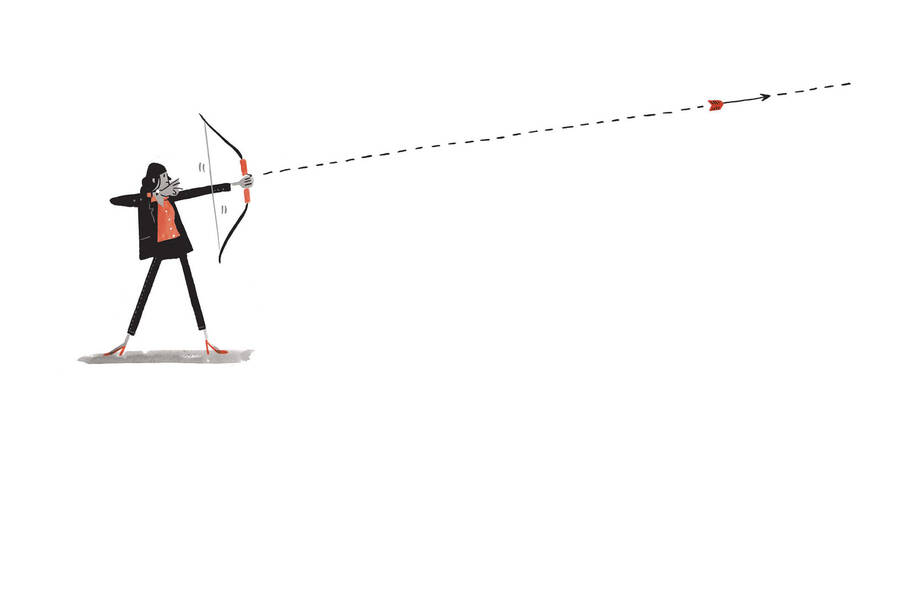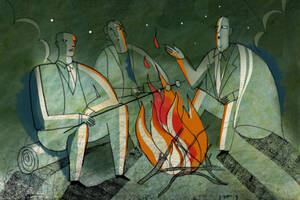
Michael Meier
The master–apprentice relationship is iconic. Whether it’s Mickey Mouse mopping floors for an imperious wizard in Walt Disney’s Fantasia or a fledgling journalist fetching coffee for a famous magazine editor in The Devil Wears Prada, the idea of an eager novice performing endless menial tasks for a powerful mentor seems natural.
Indeed, this expectation is built into many entry-level jobs in sought-after fields—from law and medicine to carpentry and plumbing. Often it’s in fields where learning on the job from an established expert is essential.
But does this relationship actually make economic sense? And if so, what economic forces are driving it?
Kellogg professor of strategy Luis Rayo, along with his coauthor Drew Fudenberg of MIT, sought to answer these questions. They modeled the apprentice–master relationship in mathematical terms and used their model to determine whether the relationship most resembled an economic quid pro quo, or something more akin to a prolonged test of skill, or merely a rite of passage.
“We’re interested in how the ‘masters’ inside a firm teach the novices,” he says. “Do they teach them as fast as they should? Do they ask them to work excessively in return?”
It’s a situation that Rayo experienced himself. As an undergraduate, he took a job as a researcher for a professor who was his “hero.”
“I was going to learn a lot from this person,” Rayo recalls. “But a lot of my time was spent basically finding typos. This is not exactly what I wanted to learn, but it was the deal. And I was very happy to do that.”
How Do You “Pay” for Master-Level Knowledge?
What Rayo and his mentor faced, he explains, was a fundamental economic problem: master-level knowledge is extremely valuable, but also very difficult to transfer efficiently.
Consider an idealized transaction between a master sushi chef and an unskilled protégé: the protégé, ideally, would simply “buy” the expertise he wants for a fair price up front, just as he would for any durable good. Unfortunately, the cash value of the chef’s accumulated knowledge is likely to exceed any amount a novice could possibly afford.
“You can, in principle, tell the master, ‘Drop everything, stop cooking for others, close your restaurant, just train me,’” Rayo explains. “And then this famous chef will say, ‘Okay, but you’re going to have to pay me five million dollars.’”
Another option would be for the master to take the apprentice under her wing in exchange for being paid back at some future date—when the apprentice, now in possession of valuable skills, can use them to earn the funds necessary to compensate the master. (Such an arrangement might look similar to a loan or a venture capital investment.) But this arrangement gives an ambitious apprentice leverage over the master, Rayo says, because a fully trained apprentice has no incentive to work to pay the master back for her “investment.”
“Once the novice learns everything he can from the master chef, he can say, ‘I’m going to open my own restaurant now to make money for myself, and not pay her back,’” he explains.
Understanding the Master–Apprentice Relationship
Given this economic impasse—a novice wishes to “buy” knowledge that she cannot currently afford from a master who cannot reliably extract payment for it in the future—how can the two parties make their exchange?
Rayo and Fudenberg developed a mathematical model to explore the question. In the model, the master and novice simultaneously choose how much time and effort to expend working with each other.
Rayo explains what the master stands to gain from investing time in the apprentice: “One way to profit from your novice is to keep him around working for a long time by training him slowly. Maybe his brain would be able to learn all of your knowledge in one or two years, but you might take ten years.”
During those additional years, the master is compensated not with cash, but with the novice’s labor.
“The novice has no money to pay for the master’s knowledge, but he’s willing to pay with extra effort,” Rayo says.
This so-called “effort distortion” creates a practical problem, Rayo says: “The master wants you to work extra hard as ‘payment,’ but early in the relationship, you’re not going to have a lot of useful knowledge—and that period is going to last a long time because the master is training you slowly on purpose.”
“The novice has no money to pay for the master’s knowledge, but he’s willing to pay with extra effort.”
So how does a master extract adequate profit out of an untrained but willing employee who is going to be around for a while? There’s only one answer: menial tasks. “You’re going to work very hard, but on stuff that doesn’t require much knowledge,” Rayo explains.
To make economic sense, this work must still be valuable to the master’s enterprise. So, interns at an investment bank may copyedit spreadsheets; medical residents may spend a large fraction of their time drawing blood or processing paperwork; entry-level kitchen employees may spend months or years chopping vegetables.
“In professions where there’s a considerable amount of knowledge to transfer, the model predicts that you’ll tend to observe large amounts of menial work early in the relationship,” Rayo says.
Finding the Optimal Relationship
The fact that the model closely matches reality helps rule out alternative explanations for the way apprentices are traditionally treated.
For instance, a master might overwork novices to evaluate their skill or intelligence. “But if that’s your motive, there’s really no reason to make them do menial work,” Rayo argues. “You would ask them to do something difficult that will allow you to more clearly distinguish who the smart ones are.”
Another potential reason for overworking apprentices or sticking them with unpleasant work could be, simply, to haze them. But hazing for the sake of hazing doesn’t benefit the master or incentivize the apprentice to stick around.
The model, in contrast, “allows you to make very specific predictions about what the optimal arrangement is” between a master and novice, Rayo says. “In a controlled way, the master is sharing secrets with you little by little, but at a rate just fast enough to keep you from abandoning them. The model tells you how long you’re going to want to keep the agent to maximize your profits.”
The Need for Thoughtful Regulations
One lesson that emerges from his model, Rayo says, is the importance of thoughtful regulations. The optimal contract, after all, is only optimal for the master, which is why many modern apprentice-style arrangements are heavily regulated.
For example, in 2003 the Accreditation Council for Graduate Medical Education introduced rules restricting the average number of hospital work-hours for medical residents to 80 per week. But Rayo’s model predicts that this kind of regulation will simply induce the hospital “masters” to extend the length of medical residencies to compensate. And there are, indeed, places where this is happening.
“If you’re serious about regulating these employment relationships, the model shows that it’s better to limit hours worked and limit the overall length of the apprenticeship at the same time,” Rayo says.
Even with better regulation, masters and apprentices won’t go away—the Mickey Mouses of the world will still have to carry water for their sorcerers. But, says Rayo, making the relationship more economically efficient—if less “optimal” for the masters—would be good for society as a whole.
“Total economic value would grow,” he says, “because apprentices will be more quickly trained and less exploited. What masters lose from the regulation is less than what apprentices gain from it.”



